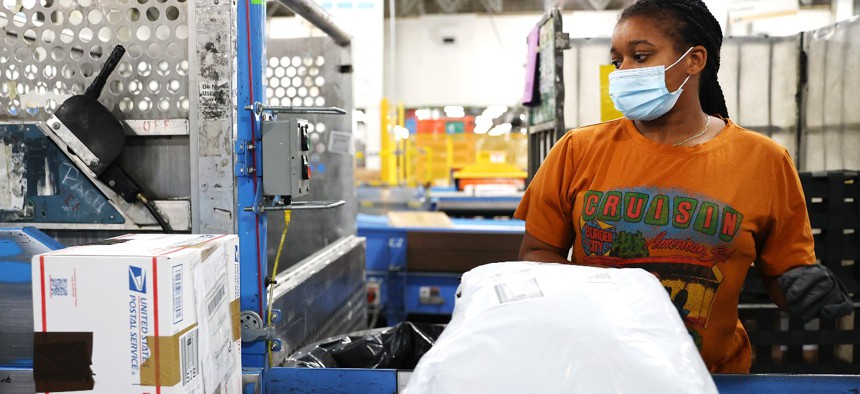
A U.S. Postal Service employee sorts parcels for distribution inside the Los Angeles Mail Processing & Distribution Center, the largest in the United States, on November 22, 2021. Mario Tama/Getty Images
This Is Where USPS Is Building Out Its First Mega-Centers This Year
The Postal Service will build out 60 new facilities as part of Louis DeJoy's 10-year plan, adding to its overall staff and improving working conditions.
The U.S. Postal Service is planning to build 60 new regional processing centers, Postmaster General Louis DeJoy announced on Tuesday, hoping to create facilities that will make the agency more operationally efficient and better for employees.
USPS will still drastically reduce its overall footprint by closing facilities that it says are redundant and create costly inefficiencies, as part of a plan it announced in May, but will replace them with new and repurposed mega-centers that can process, sort and send out for delivery mail all under one roof. DeJoy called the change a transformative investment that will make the Postal Service a more attractive place to work and enable it to meet its on-time delivery goals while maintaining its self-sustainability. The building of the new centers will take take several years to implement and are part of DeJoy’s promise to invest $40 billion in capital improvement projects.
Plans for the new or refurbished regional centers are already underway, USPS said in an internal magazine for employees, and "major initiatives" are first targeted for the Atlanta, Indianapolis and Charlotte areas this year. The goal of the new super centers is to bring all processing operations in a given metro area into one building. Some metro areas currently have up to eight processing plants with 80 delivery units—the final sorting location where carriers pick up mail and packages for home delivery—that require hundreds of trips to move the mail between them. Postal management has said it can consolidate these redundancies with a single, modernized plant that uses “standardized processes" to make the use of space more efficient.
“This new strategy will reduce redundant operations and transportation across the nation, saving us both time and money,” DeJoy said in a message to employees on Tuesday.
While USPS will eliminate many delivery units, annexes and some plants, the postmaster general vowed to invest in “most existing mail and processing facilities” to align them with the new strategy. The agency will repurpose some facilities that were previously vacated.
Dave Partenheimer, a USPS spokesman, said in May the changes were intended only to make the delivery network more intentional and efficient, not to reduce the agency's headcount. Some employees may be impacted by the consolidations, he added, but management expects the overall workforce to grow.
"Any impact on employment that may be required as a result of efficiency gains will easily be accommodated from additional growth expectations and the normal attrition we experience," Partenheimer said. "We expect to be in a hiring mode for many years to come."
The project will also build new “employee amenities” at plants and improve lighting to “reduce stress and improve morale,” DeJoy said when first announcing the plans. In a recent interview with Government Executive, DeJoy likened the existing facilities to "dungeons" and said they are causing USPS to lose employees.
“Creating the modern facilities from scratch will dramatically improve the working environment for hundreds of thousands of postal employees,” USPS said.
Existing processing facilities are outdated and designed for the needs of another era, the agency added, with decades of retrofitting creating a maze of antiquated equipment, stuffiness and artificial light.
“Configurations that once made sense now limit a location’s ability to process growing package volumes,” postal management said. “Because of these limitations, many metro-area processing facilities rely on a system of duplication and repetition, where mail and packages are ferried between a number of locations over the course of several days in half-empty trucks before they reach a carrier to be delivered.”
The Postal Service already went through one round of facility consolidations last year, when it closed 18 mail processing plants. USPS said at the time it would help the agency transition to the increase in package volume. The agency has previously faced resistance to closing plants, while failing to realize its anticipated savings when it was able to do so.
USPS is moving forward with DeJoy's plans despite President Biden's nominees now constituting a majority of the postal board of governors. Some of those board members have voiced significant reservations about elements of DeJoy’s plans, while the newly confirmed governors vowed to reexamine them.







